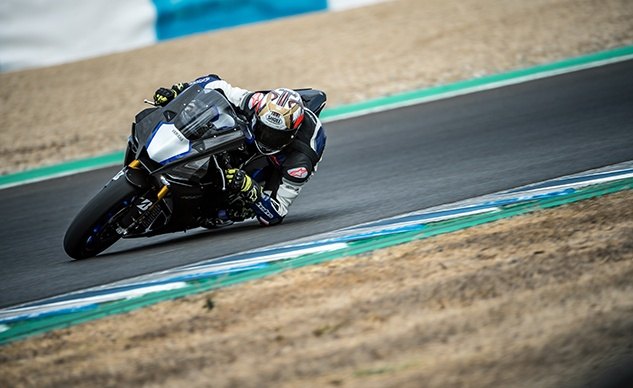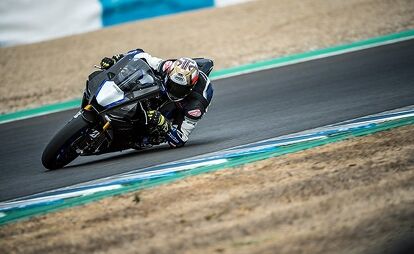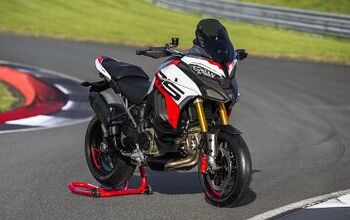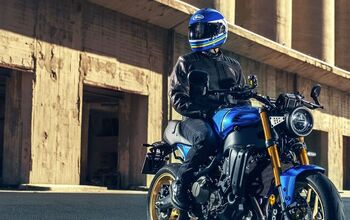2020 Yamaha YZF-R1 Review – First Ride

R1 and R1M now Euro5 compliant, without losing any of their charm
Clearly, I’m not going to turn down an opportunity to ride two of my favorite sportbikes – the Yamaha YZF-R1 and R1M – around one of the best circuits in the world, the Circuito de Jerez. But an evolution, not revolution, of the current R1 platform first introduced in 2015 (which, coincidentally, I was also present for) seemed hardly a reason for Yamaha to spend a sizeable chunk of cash to rent the world-renowned track, fly journalists in from all over the world, feed them, and put them up in a fancy hotel. What was up?
2020 Yamaha YZF-R1 and R1M
| Engine | 19.0/20 |
| Suspension/Handling | 13.5/15 |
| Transmission/Clutch | 8.5/10 |
| Brakes | 8.0/10 |
| Instruments/Controls | 5.0/5 |
| Ergonomics/Comfort | 9.0/10 |
| Appearance/Quality | 9.0/10 |
| Desirability | 9.0/10 |
| Value | 8.0/10 |
| Overall Score | 89/100 |
The simple answer can be boiled down to this: Euro5. There’s a reality we have to deal with when it comes to our internal combustion vehicles: they pollute. Whether it’s air pollution or sound pollution, governments and regulators worldwide have been cracking down on how much sound and hydrocarbons a vehicle can produce, and Euro5 regulations are the strictest regulations motorcycle makers have had to comply with so far. Nobody, not even Yamaha, is immune. Typically OEMs have complied with these regulations by adding catalyzers and other emission-reducing components to their models, and while this may bring pollution down, it also robs the engine’s power, something no consumer wants to hear. The fix? Simply making the engine bigger.
A bigger engine isn’t an option with the R1, as the 1000cc limit is what makes it legal for racing. So instead of simply adding catalyzers, Yamaha instead focused on improving the efficiency of the engine’s combustion, thus helping make a cleaner burn in the first place.
The Changes
When we gave the 2020 R1 and R1M a First Look, our man Dennis Chung went into great detail about what’s new and what the result of those changes would be. Interestingly of note, while Yamaha reps explained the changes to the new R1, no mention was made to an increase in power. Today’s literbike crop are monsters already, and the aftermarket has found a way to make even more ponies, so a cleaner-burning motorcycle was enough of a challenge.
Taking a quick look at the changes, we see the bulk of the work was done at the cylinder head, where the intake ports were shortened and intake volume reduced 12% after the throttle valve. The fuel injectors were moved on top of the throttle body instead of below, and are aimed with a straighter path towards the intake valve. The injectors themselves are now 10-hole instead of 12-hole.
To help keep temps under control, cooling passages at the exhaust ports are increased. A tweak to the rocker arm shape gives it more stability at high rpm. This works in conjunction with a new camshaft profile with the same valve lift and overlap. After the air comes in to the engine and is then burned off and expelled, it moves to the exhaust side, where the catalyzers are positioned more forward so they can come to temperature quicker and burn off spent gasses sooner.
Inside the engine, the oil pump sees a 2mm reduction on rotor width to reduce the load required on the engine to drive it (apparently the engine is getting plenty of oil, especially at high rpm). Inside the crankcase, oil passages have been reduced in size slightly, and so has the piston cooler nozzle. At the crankshaft, the big end oil passage is reduced slightly by 0.5mm, but the journal plain bearing width is increased 3mm. Yamaha says the result is more lubrication to the crankshaft and less of a chance of oil starvation, especially when chopping the throttle from wide open to zero – as you would when braking from a straightaway to a hairpin.
On the chassis side, the standard R1’s KYB fork is revised with a new piston and shim stack layout. Spring rates, too, are actually slightly decreased compared to the previous model (from 18.12 N/mm to 18.0 N/mm). In the rear, the KYB shock also gets some tweaks to match the feedback from the fork.
Having listened to the constant complaints about brake feel, the R1 gets new brake pads that Yamaha claims provide better feel for more power but similar initial bite. In another twist, the Unified Brake System has been removed, and the ABS unit is even more compact than before.
What made this generation R1 so cool in 2015 was it being the first Japanese literbike to really embrace and go all-in on electronics, centered around the 6-axis IMU which has become ubiquitous today. Lean sensitive traction control and slide control were two big features then that return now, along with lift and launch control, a quickshifter, and power modes.
New for 2020, is true ride-by-wire throttle actuation. Where before the throttle moved cables connected to a sensor, now the chip-controlled throttle is completely void of cables, with a magnet sensor at the throttle grip which sends a signal to the throttle activator.
Another new development is the ability to adjust Engine Brake Management (EBM). Controlled by the ECU based on gear position, engine rpm, throttle position, and throttle valve opening, the user now has the ability to select what kind of engine braking effect they would prefer. EBM1 delivers the same engine brake effect as before, whereas EBM2 and 3 give progressively less, though even EBM3 falls short of two-stroke levels of freewheeling.
Continuing the new developments is the Brake Control System (BC). Like EBM, the Brake Control System allows the user to choose between two different ABS settings. BC1 amounts to fixed ABS with intervention algorithms identical to the previous R1. BC2, however, allows ABS sensitivity to increase with bank angle and slipping rate data from the IMU. While not much of a benefit (and probably more of a hindrance) while riding on track, BC2 has the potential to be very useful on the street, where the conditions are constantly varying.
For the racers out there, the Launch Control settings are also updated, with LCS1 now launching at a higher engine speed – 9,000 rpm vs. 8,000 rpm – due to the throttle valve angle staying put at 41º instead of the previous 38º. LCS2 remains the same as before.
R1M
Moving to the R1M gets you more carbon fiber, updated electronics, along with the latest spec Öhlins ERS (Electronic Racing Suspension). Oh, and there’s a $9,000 price difference, too ($17,399 vs. $26,099).
Like the standard R1, updates to the M version are an evolution, not revolution, from before. The M gets the latest edition of the NPX ERS fork from Öhlins with revised algorithms and the pressurized gas chamber built into the fork body – the first for a production motorcycle, according to Yamaha. Like the standard R1, the spring rate has also been reduced slightly, from 21 n/mm to 20 n/mm. At its core, the NPX fork is still a conventional design, with springs, shim stacks, and valves, but here the valving is electronically actuated in real time, making it more of a semi-active system. The ERS shock has also been tweaked a little to match the front, with a new compression piston, different valve settings, and a 4mm increase in spring preload to raise the rear a little.
Just as before, the stand out feature of the R1M is the Communication Control Unit (CCU), which lets a rider make changes to their R1M via the YRC settings, and see how well (or how poorly) they’re riding through the Y-TRAC app, now with iOS compatibility. The CCU records data collected by GPS, IMU, and ECU to analyze 16 channels of data for each lap around a racetrack – essentially giving you a watered-down version of what race teams look at to help their rider go faster. If you have a faster buddy on another R1M, you can look at the data from both bikes to compare/contrast and see each other’s strengths and weaknesses.
From there, the R1M sees a new nose fairing, front fender, side fairings, and tail pieces – all from carbon fiber – to complete the exclusive M look, and the airbox badge is numbered.
Ride Impressions
While it may not have the cache or prestige of some of its European competitors, the R1 continues to be one of my favorite liter-class sportbikes (on track anyway. It’s torture on the street). Few motorcycles can match the heavenly tune of the R1’s offset firing order when it’s singing at full song, and this is made even better by how communicative the throttle is to the rider’s right hand – which is the whole point of the crossplane crankshaft anyway.
If you’re already familiar with the last R1, then the 2020 version won’t feel much different. Starting our day with the standard R1, it’s remarkable how quickly I felt comfortable on it despite not having ridden one for quite some time. It’s been a decade since I last saw Jerez, and re-learning the track aboard the R1 couldn’t have been easier. I chalk this up to a few things: first, as mentioned before, is the connection between the right wrist and the rear tire. The R1 delivers a lot of power, but it all feels manageable (assuming you have the skillset to begin with – the R1 is not a beginner’s motorcycle). Yamaha reps didn’t make any mention of this, but the fuel mapping, especially in Power Modes 1 and 2 (the two most immediate and powerful settings) is much smoother than past Yamahas I’ve ridden. Personally, I preferred Power Mode 2 for its slightly less aggressive initial hit.
Second, the chassis inspired all kinds of confidence to tip the Bridgestone R11 tires into every corner (B-Stone RS11 tires will come standard from the showroom floor) at whatever lean angle I liked, with precise feedback from both the chassis and tires themselves.
Third, I was assured by the safety net the sophisticated electronics provided. A decade ago, when I was last at Jerez, I rode a Ducati 1098R with the first traction control system fitted to a production motorcycle. While nice to have, its intervention was obvious and jarring, as the constant cuts of power detracted from putting down a quick lap. Ten years on and the R1’s rider aids are hardly noticeable. That’s a testament to how far we’ve already come in developing these technologies, which should make all of us excited by the possibilities of what’s to come.
By the end of the third and final session (which was the sixth session for the R11 tires as the bikes were shared), it was clear their performance was heading south. Side grip had gone down while, conversely, my confidence and track knowledge went up. Diving deep into Turn 5, the Sito Pons corner, you need to get on the gas as early as possible to get a good drive down the back straight. Doing so on the worn tires immediately led to a big slide – and while I’d like to say my skill kept me from reaching orbit – the seamless intervention from the traction control is closer to the truth.
Looking back to 2015 when the first iteration of the current R1 was introduced, I distinctly remember how well the adjustable wheelie control would allow the front to lift under power and then calmly come back down. It’s more of the same for 2020, and you can especially feel it exiting the tight hairpin final corner at Jerez. Coming off the final turn you’re hard on the throttle, which naturally brings the front end up. Lift control then goes to work and is slightly noticeable as it tries to figure out how much power to deliver to keep you driving forward while keeping the front wheel from getting too high. Upshifting then brought the front back down pretty quick. Personally, having peace of mind to simply open the throttle gave my brain more space to focus on going quick. It should be noted I was riding in Lift Control 2. Switching down to 1 gives more control to the rider. Other, braver, souls I talked to, including multi-time MotoAmerica Superbike champ Josh Hayes, and former Canadian Superbike champ and World Superbike racer Brett McCormick, preferred turning the feature off completely and letting their skills do the talking.
Once again, if the R1 has a weak spot, it’s the brakes. While overall power is good and the feel from the new pads is better, I’d still prefer more. More power, more initial bite, and LESS ABS. Occasionally hard braking and three quick downshifts from the back straight to the tight Dry Sack hairpin would activate ABS even if it wasn’t needed, especially in the rear, which on one occasion caused me to run wide and blow the corner entirely.
R1M
Switching over to the R1M – and Bridgestone V02 slicks – for the second half of our ride day, the experience was… largely the same. This shouldn’t come as much of a surprise considering the main mechanical difference is the suspension. However, the difference between the analog and semi-active suspension was definitely notable. As you’re putting heavy braking loads on the fork, you can feel the electronic suspension reacting and making changes to provide more stability and support under braking. All within fractions of a second. The same is then true for the shock on acceleration.
The difference in experience comes after you step off the R1M and can download your ride data. Looking at the app one can see all their laps, with a myriad of data sets at your disposal. While there are 16 different data overlays you can view, my laps were each broken down by percentage of throttle, GPS speed, gear position, along with when and where any of the different rider aids were activated, all laid out over a graph and a Google Maps trackmap. It truly is next-level stuff for anyone who isn’t on a factory racing team.
Where Do We Go From Here?
It seems like we say it all the time with flagship sportbikes, but as technology keeps moving forward we’re always left wondering what’s next. With the R1 and R1M, Yamaha has improved upon its already well-liked literbike with little advancements here and there that just firm up an already solid package. I’m stopping short of calling it my favorite bike in the class, as the competition is extremely stiff, but as far as Japanese literbikes go, it definitely gets my vote. It’s simply an easy motorcycle to ride fast, if such a thing in this category even exists. Not to mention it sounds incredible doing it, too.
Both the R1 and R1M will hit dealerships in October 2019, the standard for $17,399. At that price, the R1 undercuts Aprilia’s RSV4 RR by just $100. That’s an incredibly difficult choice to make. Meanwhile, the M model will come in limited quantities with reservations being taken online on Yamaha’s website.
2020 Yamaha YZF-R1 and R1M
+ Highs
- Excellent electronics
- Confidence-inspiring chassis
- That killer crossplane soundtrack!
– Sighs
- Brakes could still use more bite
- $26k seems a little steep for the R1M
- Uhh…
2020 Yamaha YZF-R1 Specifications (R1M In Parenthesis) | |
|---|---|
| Engine type | Liquid-cooled inline 4 cylinder DOHC; 16 valves |
| Bore x Stroke | 79.0mm x 50.9mm |
| Displacement | 998cc |
| Compression Ratio | 13.0:1 |
| Fuel system | Fuel injection with YCC-T and YCC-I |
| Transmission | 6-speed cassette type gearbox with up-and-down quickshifter |
| Clutch | Multi plate wet clutch with mechanical slipper system |
| Traction Control | 6-axis IMU enables lean-sensitive Traction Control System (LCS), Slide Control (SCS), Lift Control (LIF), Launch Control (LCS) |
| Front Suspension | 43mm KYB inverted fork, fully adjustable; 4.7-in travel (43mm Öhlins Electronic Racing Suspension NPX fork, fully adjustable; 4.7-in travel) |
| Rear Suspension | KYB single shock, fully adjustable; 4.7-in travel (Öhlins Electronic Racing Suspension single shock, fully adjustable; 4.7-in travel) |
| Front Brakes | Dual 320mm hydraulic discs with radial-mount 4-piston calipers; Brake Control System and ABS |
| Rear Brakes | 220mm hydraulic disc; Brake Control System and ABS |
| Tires | Front: 120/70 ZR 17 Bridgestone RS11 Rear: 190/55 ZR 17 Bridgestone RS11 (200/50 ZR 17 Bridgestone RS11) |
| Rake/Trail | 24.0° / 4.0 inches |
| Wheelbase | 55.3 inches |
| Length | 80.9 inches |
| Width | 27.2 inches |
| Seat Height | 33.7 inches |
| Curb Weight | 448 lbs (450 lbs) |
| Fuel Capacity | 4.5 gallons |

Troy's been riding motorcycles and writing about them since 2006, getting his start at Rider Magazine. From there, he moved to Sport Rider Magazine before finally landing at Motorcycle.com in 2011. A lifelong gearhead who didn't fully immerse himself in motorcycles until his teenage years, Troy's interests have always been in technology, performance, and going fast. Naturally, racing was the perfect avenue to combine all three. Troy has been racing nearly as long as he's been riding and has competed at the AMA national level. He's also won multiple club races throughout the country, culminating in a Utah Sport Bike Association championship in 2011. He has been invited as a guest instructor for the Yamaha Champions Riding School, and when he's not out riding, he's either wrenching on bikes or watching MotoGP.
More by Troy Siahaan





































































































































































Comments
Join the conversation
I dont understand this EURO5 and who it relates to but how can they have plated 2strokes in Europe also??
Surprised Yami didn't seize the opportunity for more displacement. All the top superbikes are going that route and leaving the liter stuff for homologated race specials.